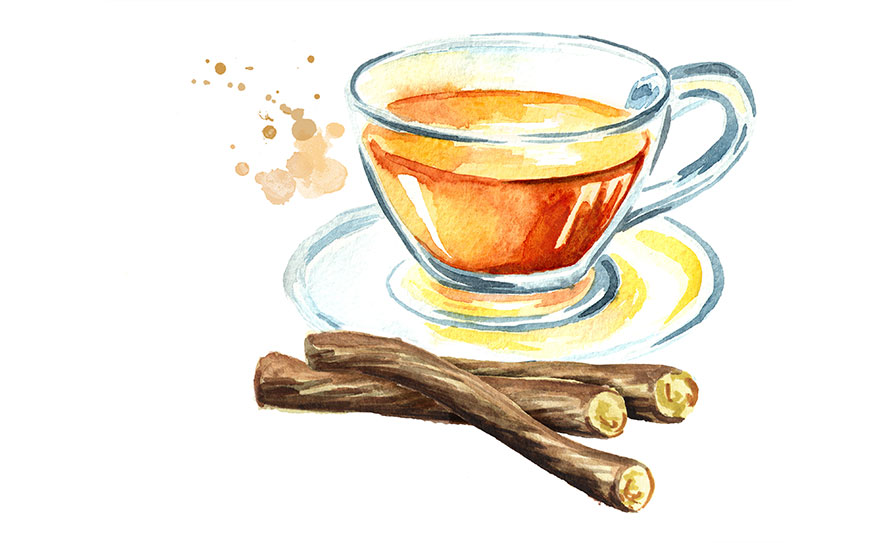Liquorice has many uses, because its main chemical component glycyrrhizin is some 30-to-50 times sweeter than sucrose. This makes it a sought-after flavouring agent in tobacco products and of course in confectionery. In the halcyon days of extemporaneous compounding, liquorice extracts were often used to mask the taste of bitter drugs. But it did have much more to offer medicinally than being a mere formulation aid. In TCM, liquorice is frequently included in complex multi-component formulations as a ‘guide’ or ‘envoy’ ingredient that harmonises and integrates the actions of other ingredients. Up to relatively recently, liquorice extracts and isolated constituents from the root were go-to treatments in Western medicine for peptic and duodenal ulcers.
Some of the names applied to those constituents can be confusing. Suffice to say that glycyrrhizin is named after the Latin botanical name for liquorice, Glycyrrhiza glabra. ‘Glycyrrhizin’ is the calcium and potassium salt of glycyrrhizinic acid, which in turn is a triterpene saponin glycoside, in which the non-sugar is called either ?-glycyrrhetinic acid or ?-glycyrrhetic acid. The root contains between 2 and 15 per cent of glycyrrhizin, depending on the type of liquorice and where it is grown. The sugar part of the glycoside is comprised of two molecules of glucuronic acid. Glycyrrhetinic acid has the INN name of enoxolone. A semi-synthetic modification of it, in which the diglucuronide element is replaced by succinic acid, is known as carbenoxolone, which was also marketed as a remedy for stomach ulcers. A gel containing it is licensed by the HPRA as a medicinal product for the symptomatic relief and treatment of lip sores, mouth ulcers or aphthous changes in the oral mucous membranes.
Glycyrrhetinic acid has a chemical structure similar to that of cortisone. As a result, liquorice, its extracts and isolated constituents all have anti-inflammatory and mineralocorticoid activity that explains its efficacy in ulcerative conditions. One possible explanation for this effect could be the ability of glycyrrhizin, etc, to bind to the mineralocorticoid receptors in renal tissues. An alternative mechanism could be related to the fact that the liquorice molecules are potent competitive inhibitors of 11 ?-hydroxysteroid dehydrogenase. Low 11 ?-hydroxysteroid dehydrogenase activity results in higher concentrations of cortisol in humans. That cortisol in turn reacts with the mineralocorticoid receptor to promote sodium reabsorption.
Unfortunately, that activity has contributed to the decline in the value of liquorice as an anti-ulcer treatment (though the emergence of the acid pump inhibitors undoubtedly played a large part too). The mineralocorticoid activity results in serious side-effects due to the pseudoaldosteronism it causes. These include oedema, sodium retention, and hypokalaemia leading to hypertension. As a result, the European Scientific Committee on Food in 2015 advised that daily intake of liquorice-containing confectionery should not exceed 100mg of glycyrrhizin. Many liquorice sweets are likely to contain quite low levels of liquorice itself and what consumers think is the characteristic taste of liquorice is actually anethole from the oil of aniseed oil or star anise. This is used to reinforce the taste of the liquorice flavouring. So, the risks are likely to be low, except where someone is regularly consuming black liquorice extract that is 100 per cent pure as sold on the continent and this could be problematic, and in extreme cases, fatal.
Modern interest in liquorice derivatives has centred on its role in protecting the liver from damage
The Herbal Committee at the EMA has published a Community Herbal Monograph for Liquorice Root, in which two traditional use indications were agreed. The first was for the relief of digestive symptoms, including burning sensation and dyspepsia. The second was as an expectorant in cough associated with cold. The EMA decided that clinical trial data, while showing evidence of activity in cases of dyspepsia, was insufficient to justify a Well-Established Use indication in the Monograph due to the small number of participants. The Assessment Report drawn up by the committee noted that some studies showed that glycyrrhizin-free extracts had been marketed in order to avoid the above-mentioned side-effects. Some pre-clinical and clinical studies indicated an anti-ulcer effect due to the presence of flavonoids, but the EMA stated that the overall weight of the clinical evidence did not support an indication claim.
Modern interest in liquorice derivatives has centred on its role in protecting the liver from damage. Liver injury can occur after administration of a number of drugs, but it is the commonest complication of anti-TB therapy (rifampicin, isoniazid, pyrazinamide and ethambutol) occurring in 2.5-to-43.5 per cent of cases. The resulting elevation of liver function tests and symptoms of jaundice and hepatitis can lead to the premature discontinuation of anti-TB therapy and can be life-threatening. A paper in the journal Phytomedicine earlier this year described the results of a meta-analysis of 97 RCTs of glycyrrhizin preparations in preventing and treating anti-tuberculosis DILI. The preparations tested in the clinical studies included glycyrrhizin, glycyrrhizinic acid, monoammonium glycyrrhizinate, di-ammonium glycyrrhizinate liposomes, and magnesium isoglycyrrhizinate (MGIG). Prevention studies numbered 33 and involved 5,762 participants. Compound glycyrrhizin capsules and diammonium glycyrrhizinate capsules, along with the enteric capsule and injectable forms, significantly reduced the incidence Of DILI compared to controls. In the treatment studies involving 64 RCTs and 5,161 patients, MGIG was the most effective of the regimens. According to the Chinese authors, there are a number of mechanisms that could contribute to the effectiveness of liquorice derivatives in alleviating liver disease, including the well-documented anti-inflammatory effect and the ability to attenuate hepatocyte apoptosis. Other mechanisms include an anti-oxidative stress effect and immune regulation. The authors noted a lack of data for a preventive effect of MGIG and called for further investigation on the grounds that a 2018 meta-analysis had shown a reduction in the incidence of DILI in cancer patients undergoing chemotherapy. They further noted that current treatment guidelines for anti-TB DILI do not include liquorice, but suggest that their analysis should prompt a reconsideration.
Renewed interest in liquorice also centres on its antiviral activity against influenza virus and HIV and notably, against coronavirus-SARS-2. In the latter case, it acts by reducing the expression of angiotensin-converting enzyme 2 (ACE-2) employed by the virus to attach itself to cells in the body. While there are no certainties in pharmaceutical and medical research, it would appear to be too soon to consign liquorice to the dustbin of history.
CONTRIBUTOR INFORMATION
Dr Des Corrigan, Best Contribution in Pharmacy Award (winner), GSK Medical Media Awards 2014, is a former Director of the School of Pharmacy at TCD and won the Lifetime Achievement Award at the 2009 Pharmacist Awards. He was chair of the Government’s National Advisory Committee on Drugs from 2000 to 2011. He currently chairs the Advisory Subcommittee on Herbal Medicines and is a member of the Advisory Committee on Human Medicines at the IMB. He is a National Expert on Committee 13B (Phytochemistry) at the European Pharmacopoeia in Strasbourg and he is an editorial board member of the Journal of Herbal Medicine and of FACT — Focus on Alternative and Complementary Therapy.







